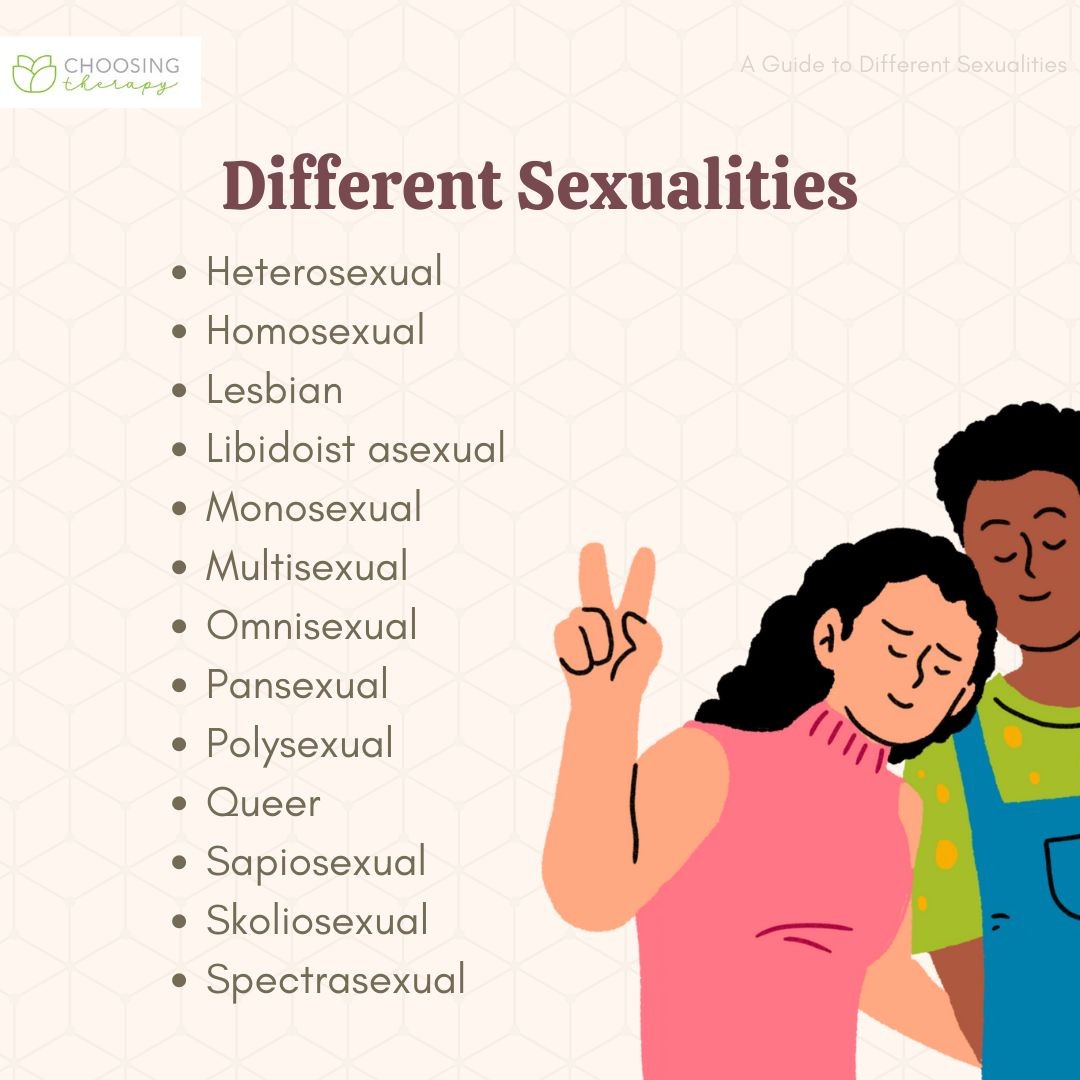
Contents
What Is an Example of Sexuality? (21 Types)
Here are 21 examples of different sexualities that people use to describe their bodies and the people they are attracted to.
Here are 21 examples of different sexualities:
- Ally: A person who supports all sexual orientations and fights against homophobia and heterosexism.
- Asexual: A person who lacks sexual orientation and is not sexually attracted to anyone.
- Bear: A person, typically male, with facial or body hair and a cuddly body. The term "bear" can have different meanings to different people.
- Biphobia: Fear or discrimination against bisexuals.
- Bisexuality: A sexual orientation in which a person is attracted to more than one gender.
- Coming out: The process of recognizing and accepting one’s LGBTQIA+ status.
- Down low: Concealing one’s same-sex attraction and relationships while being in different-sex partnerships.
- Family: Term used by LGBTQIA+ individuals to identify others in the community.
- Gay: A term used to describe male homosexuals, but can apply to all genders.
- Heteronormativity: The belief that everyone is heterosexual and that heterosexuality is superior.
- Heterosexism: Discrimination or hatred against nonheterosexual individuals and groups.
- Heterosexual privilege: Advantages given to heterosexual individuals but denied to LGBTQIA+ individuals.
- Homophobia: Fear or hatred of homosexuals and homosexuality.
- In the closet: Concealing one’s LGBTQIA+ status in certain contexts.
- Lesbian: A term for a woman who is only interested in other women.
- LGBTQIA+: An abbreviation for lesbian, gay, bisexual, transgender, queer, intersex, asexual, and other unidentified genders.
- Outing: Informing others about a person’s LGBTQIA+ status without their permission.
- Pansexual: A person who is attracted to people of all or most gender identities.
- Polyamory: Having open, nonpossessive relationships with multiple people.
- QTPOC: Queer and transgender people of color.
- Transvestism: Intense sexual arousal from cross-dressing.
What is sexuality?
Sexuality refers to how people interpret their bodies and the people they are emotionally and sexually attracted to.
It includes aspects such as:
- Identity
- Values and views about bodies
- Sexual and emotional desires
- Relationships
- Gender
- Thoughts and feelings about these aspects
Sexuality encompasses feelings and attraction to others. There are many different forms of sexuality, and it takes time for people to understand their own.
A person’s sexuality is a fundamental part of who they are and can influence their thoughts, feelings, and behaviors. It is natural and part of the broad range of human experiences and relationships.
Because sexuality is complex, each person’s understanding of their own sexuality is unique and ever-changing. There is no one-size-fits-all approach, which is why there are numerous terms to represent different sexual orientations.
What is the difference between sexuality and sexual orientation?
- Sexual orientation: A person’s identity based on the sex they are attracted to. It can be expressed in various ways.
- Sexuality: How a person sexually expresses their thoughts, feelings, and attraction toward others. It is based on their sexual orientation.
For example, regardless of sexual orientation, individuals can have specific sexual practices or fetishes that they enjoy.
Sexual practice is an important aspect of understanding sexuality, and it is defined by a person’s feelings rather than who they have sex with. Sexual orientation, on the other hand, is defined by who a person is sexually attracted to.
QUESTION
What is the philosophy of sexuality?
The philosophy of sexuality explores various aspects of sexual desire and its role in emotional health and growth.
- Procreation: The production of offspring.
- Contraception: Measures taken to prevent pregnancy.
- Celibacy: Abstaining from marriage or sexual relationships.
- Marriage: The legal union of a couple.
- Adultery: Engaging in sexual relationships with someone other than one’s spouse.
- Casual sex: Sex between two people who are not in a relationship.
- Flirting: Playful acts that demonstrate sexual attraction.
- Prostitution: Engaging in sexual activities for money or other commercial benefits.
- Homosexuality: Engaging in sexual activity with someone of the same sex.
- Masturbation: Arousing oneself sexually by stimulating one’s own genitals.
- Seduction: Attracting others for sexual purposes.
- Sadomasochism: Gaining sexual pleasure from inflicting pain.
The normative philosophy of sexuality explores the value and forms of sexual engagement and pleasure. It delves into the moral responsibilities and boundaries of sexual interactions.
Overall, the understanding of sexuality is unique to each individual and is influenced by personal experiences and perspectives.


